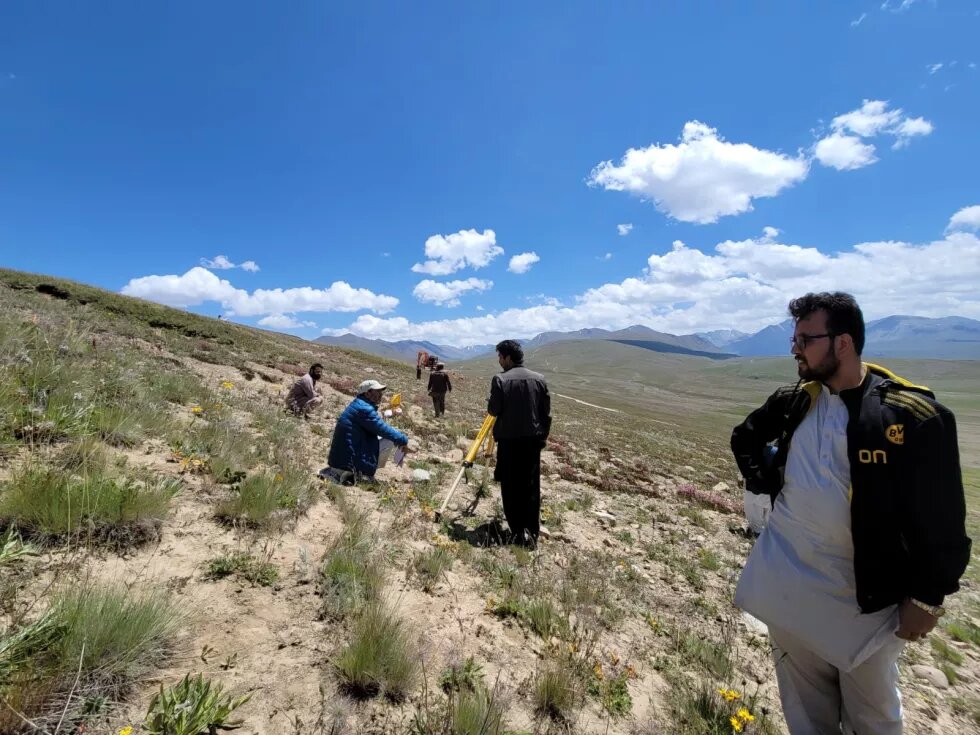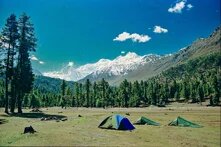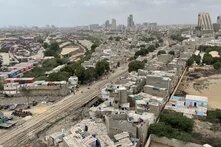
Is water diversion from Deosai National Park the only solution?

Skardu[1], once a home to clean spring water running out of its streams and earthly channels, has been facing severe water shortage since the early summer of 2023 due to climate change impact in the region, a rapid increase in population, and a fast-growing tourism. This crisis has not only put at risk the geographic survival of local people, including farming community, but also severely impacted their livelihoods.
“If immediate measures are not taken to resolve the issue, the situation will further exacerbate, ultimately resulting in a demographic change in the society,”
warns a local journalist, Rajab Qamar.
In the past, the city had never been confronted with such an acute water crisis, as water distribution system was properly managed by the municipal authorities. However, due to decreased supply, the residents are now compelled to fetch water from the Indus River, which flows about 10 km away from Skardu town.
“The commercial tankers have capitalized on this necessity by selling water to the residents. This has reduced the agricultural prospects too, resulting in less vegetation, and drying up of the thriving fishponds,”
: Rajab Qamar
It is paradoxical that a valley, which has streams, springs, rivers, and snow-capped mountains lacks sufficient water and its occupants are compelled to purchase it. Water shortage is not only impacting household chores but also farming, which is the primary source of income for local people. Mostly, the crops and vegetables’ cultivation[2] serves the local needs. However, horticultural crops are primarily produced to get commercial incentives. Though the livelihood of many people is linked to the produce of apples and grapes, it’s the apricot orchards that dominate the fruit market landscape.
Owing to the dwindling water supply this year, the apricot orchards have been badly affected; the anticipated bloom of flowers on fruit-bearing trees is not seen as it used to be in the past; the birds once seen flying under the blue skies have changed their perching places because of the empty waterways in the city. The entire Skardu community is in a state of shock on the current water scenario and is awaiting some celestial help to get rid of the trouble that may prolong as time passes.
Fall in the snowfall!
Water is supplied to Skardu town from Sadpara Lake[3] on which a dam is now constructed by Water and Power Development Authority (WAPDA) for electricity generation. The town’s water demand for both agriculture and domestic purposes is met by the lake. During the summers, Skardu's water demand stands at 55 to 60 cusecs whereas it is reduced to 40 to 45 cusecs during the winters. The lake and dam receive water after snow at Deosai National Park and its surroundings melt in the months from May to July, fill the dam and later released through different nullahs (streams and drains).
“Usually, the Park and its surrounding areas receive heavy snowfall in winters, but there is notably less snowfall in 2023 that resulted in adverse water shortage; even Skardu town received about 30 per cent less snowfall this year,” said Engineer Zulfiqar Haider, an official of Public Health Department, Skardu.
Causes of water scarcity
Experts attribute part of the water crisis to abnormal weather patterns with less snowfall in winter and below-average temperatures in summer. However, the growing population and booming tourism in Skardu are also the major causes of an increase in water consumption.
According to 1998 census, the Skardu population was 127,579 individuals whereas in 2017, it jumped to 260,000 that was almost doubled. Ultimately, the per capita share is on the decline that is one of the reasons for water shortage in the town. According to local authorities, there is a significant increase in Skardu population during the past years, however, no official figures are available after 2017.
Apart from local population, the regular arrival of tourists in Skardu also adds up to water consumption. It is believed that tourists consume more water than residents especially in developing countries. According to the Tourism Department of Gilgit-Baltistan (G-B), approximately 0.2 million foreign tourists visited G-B in 2022 and the number crossed 0.25 million in the first eight months of 2023. Almost all the tourists, who visit G-B, first arrived in Skardu and then choose to disperse elsewhere. Thus, the city population becomes doubled in summers, which is a major reason behind increase in water consumption.
Initiation of water schemes
To address the water challenge, the G-B government has initiated a number of schemes, including the Shatung Nullah Water Diversion Project, which is likely to be completed by the year end. Currently, extensive surveys led by WAPDA are going on in this regard.
A community-owned scheme, namely ‘Diversion of Water from Phia Lung to Sadpara Nullah’ has been launched recently at a cost of Rs 1.5 billion. An estimated 250,000 people will benefit from this initiative and 15,000 hectares of agricultural land will be irrigated.
“The preliminary work on the project has been started. A 10-km long road is under construction to move further for the subsequent developments, including the construction of concrete water channels for diverting water from the Phia Lung to the Sadpara dam and lake," said Nazir Ahmed, the Project Director.
Sadpara nullah typically flows with an average of 250 to 300 cusecs of water. Upon the project completion, an additional 110 cusecs will run through this channel downstream. Furthermore, the project is expected to cater to the needs of thousands of tourists, giving a big boost to the local economy. More importantly, it will extend the lifespan of the Sadpara dam. Besides, it will also contribute to electricity generation.
Controversy over proposed water diversion
To fulfil the water demand of Skardu residents, it was proposed to divert water from a nullah situated within the pristine Deosai National Park[4]. This diversion may cause harm to the ecosystem of the park, which is a habitat for 11 threatened species of large mammals, 13 species of small mammals, 03 species of reptiles, 130 species of birds, 03 species of fish, and a staggering 582 species of plants, reveals a study conducted by Heinrich Böll Stiftung in 2017.
Phia Lung water resource flows northward that is its natural course whereas the project's intent is to redirect this flow toward the south, a move that has raised concerns and reservations from the Wildlife Management Board of Skardu-Baltistan[5]. - The Board has declared Phia Lung to Sadpara nullah water diversion project illegal.
In an official letter, the Board requested the G-B government to intervene in the matter. The letter further reads: “They are working without No Objection Certificate (NOC) and are not following rules and regulations. It may create a serious law and order situation, therefore kindly approach the high-ups and direct the district administration to stop them from construction work.”
Independent experts are of the view that though the project is beneficial in the eyes of the community, it may put adverse effects not only on Deosai National Park, but also on the ecosystem of Skardu and Karakoram-West Tibetan Plateau.
“Even minor disruptions have the potential to inflict devastating harm upon the fragile ecosystems. It is hazardous not only for water resources but also for environment and might render water unsuitable for both agriculture and drinking purposes. Any attempt to disconnect water from its natural course can cause calamity,” warns Dr Hassan Abbas, a water management expert and Founding Chairman of ZiZAK Ltd.
It is particularly noteworthy that Deosai National Park is a habitat for the rare brown bear and other wildlife species which will be endangered by this project. Indeed, the water problem in Skardu town is a serious issue, there is a need to explore other suitable options to overcome the crisis.
“The use of concrete in water channels poses a serious threat to the ecosystem. Deosai area is replete with diverse flora and fauna and harbors invaluable herbal plants. In case you disrupt or divert the natural water flows, it would destroy the vital wildlife habitats,” says Nauman Rasheed, a former official of the Environmental Protection Agency, Khyber Pakhtunkhwa.
Alternate ways to resolve crisis
The issue of water shortage can be resolved by utilizing snow for domestic and agricultural purposes. Over the years, there has been a decrease in snowfall, but it is still sufficient if stored in a proper way. Nauman Rasheed proposes the formation of artificial glaciers at appropriate places. Similarly, he adds that underground tanks and reservoirs may be built for snow storage. These methods do not disrupt the natural flow of traditional watercourses and streams, ensuring their continued use for agriculture.
For sustainable agricultural practices, Dr Hassan Abbas recommends two effective techniques for water conservation, i.e. sprinkler system[6] and drip irrigation method[7]. These contemporary methods are practiced globally, especially in the areas where water is scarce.
It is assessed that the water demand will increase with the passage of time whereas the possibility of less water supply through Phia Lung canal also exists. If the project fails to deliver in future, then all the efforts and money will go to waste.
Dr. Hassan Abbas proposes an alternate method to extract water without disrupting the Indus River's natural course, i.e. tapping subterranean water sources, located near the river bank under the sand and stones, by digging tube wells there. This method is usually observed in riverside cities in the world. It has given proven results in terms of tapping water resources causing no environmental hazards. The water collected by using this method is clean and free from any risks that are often associated with open-flow sources.
“This method is not only more environment-friendly but also inherently sustainable, as the underground water reservoirs remain largely unaffected by fluctuations in river water levels. The tube wells may be installed alongside the Indus River, as they will pose no threat to ecosystem.” Dr Abbas said.
Conclusion
In the light of the above discussion, one can argue that the water dilemma in Skardu is a matter of grave concern and needs immediate attention of the authorities. Otherwise, it may create law and order situation in the town. To save the ecosystem of the Deosai National Park and biodiversity of the area, other options must be considered. There is a need to explore more alternatives to resolve the issue of water shortage in Skardu town. In this regard, i) a committee comprising environmentalists, water experts, government officials, local leadership, local government representatives, media and farmers should be constituted to thoroughly review the issue from all the perspectives and prepare a fact-finding report, and ii) the services of independent experts and researchers from the region and abroad need to be hired to conduct a detailed study on this issue. Later on, the G-B government may take a decision in the light of the independent research findings and suggestions of the committee.
Endnotes
[1] Skardu, a mountainous district in Gilgit-Baltistan province of Pakistan, is a gateway to majestic K2 and shares a long area of famous Deosai National Park.
[2] Wheat, barley, and millet are major crops of the area. Among vegetables, very tasty potatoes are grown here.
[3] The lake is a beautiful natural wonder which is 7km away from Skardu town towards Deosai National Park. It is fed by Sadpara stream from the melting ice of the Park.
[4] Deosai National Park is a remarkable natural enclave nestled in the Western Himalayas of Gilgit-Baltistan.
[5] It is a government entity entrusted with the custodianship of Deosai National Park.
[6] In this system, a network of pipes is set up to take channel water to central points in the farm. These sprinklers disperse water evenly across the fields, optimizing its utilization.
[7] This method involves the installation of plastic pipes in rows near crops or plants, featuring small perforations. Water seeps from these openings, delivering precise amounts drop by drop.



